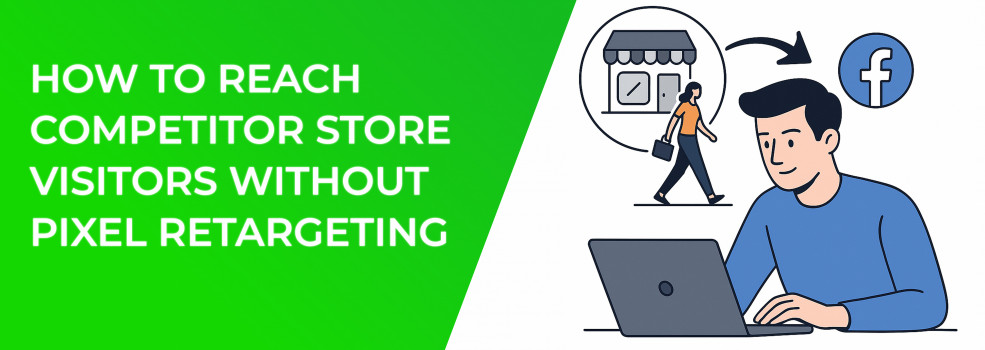Privacy-first marketing doesn’t have to sacrifice performance. Thanks to a steadily shrinking supply of third-party cookies, the classic Facebook Pixel approach reaches fewer people every month. Yet shoppers who have just walked out of a rival’s store remain some of the hottest prospects you can speak to. This playbook mixes modern Facebook ad optimization tactics with creative audience building so you can target customers on Facebook, no pixel required.
1. Face Reality: The Pixel Is Losing Signal
The browser pixel records only a slice of traffic after iOS App Tracking Transparency, stricter GDPR enforcement and Chrome’s cookie exit. To keep measurement tight, many advertisers now combine:
-
on-platform engagement events (video views, post reactions, profile taps)
-
server-side Conversions API hits that you own
-
customer lists created from first-party data partners
Result: you still feed Meta high-quality signals while staying compliant.
Pixel-based tracking is losing power, especially after iOS 14 and cookie deprecation.
Facing the same privacy headwinds? Combating iOS Privacy Changes: Smart Ad Targeting Strategies for Facebook breaks down additional work-arounds you can layer on top of the ideas above.
2. Geo-Conquest Competitor Foot Traffic
Opt-in location data lets you build a custom audience on Facebook composed of real-world store visitors.
-
Draw a geofence around each competitor location or upload a POI file.
-
Filter for a five-minute dwell time within the last thirty days.
-
Export device IDs, hash them and create custom audience on Facebook in Ads Manager.
Layer an exclusion for existing buyers so you only speak to fresh prospects. Expect stronger click-through rates than broad interest targeting.
3. Stack High-Intent Engagement Audiences
Not every consumer shares location, so add on-platform actions to widen reach. Run product demos, carousels and lead forms, then retarget people who:
These signals drive Campaign Budget Optimization faster than pixel events alone.
4. Combine Interests With Buying Behaviors
If you’re new to audience building, start with Facebook Ad Targeting 101: How to Reach the Right Audience for a quick refresher on core targeting levers.
Interest targeting gets razor-sharp when you pair competitor brand names with behaviors like Engaged Shoppers or Frequent In-Store Shoppers. Add demographics — age, gender or ZIP — if you sell locally. This hybrid method keeps CPMs low while honing in on ready-to-buy users. Choosing the wrong campaign type can sink even perfect targeting; Meta Ad Campaign Objectives Explained walks you through picking the objective that lines up with your audience strategy.
5. Expand With Lookalikes and Advantage Campaign Budget
After conversions start flowing, create 1–3% lookalike audiences from “store-visitor purchasers.” Switch on Advantage Campaign Budget (Meta’s update to Campaign Budget Optimization) so spend automatically shifts to the best-performing ad set. Exclude the seed audiences to keep prospecting net-new.
Lookalike audiences allow you to scale up by cloning your best buyers.
Need a refresher before cloning your best buyers? Custom vs Lookalike Audiences: What Works Best for Facebook Campaigns? details when, why and how to use each option effectively.
6. Tune Creative and Budgets
Speak to competitor pain points such as limited sizing or slow checkout, then position your brand as the fix. Popular hooks include bundled gifts, loyalty points or free express shipping. Feed your catalog via the Conversions API so you can still run dynamic Facebook conversion ads without browser pixels. To ensure Meta optimizes even faster, bookmark How to Finish the Facebook Learning Phase Quickly and apply its checklist right after launch.
Track daily:
-
Outbound CTR ≥ 1%
-
Cost Per Add-to-Cart trending down
-
Positive ROAS verified through offline uploads
If those numbers dip, run through the fixes in Facebook Ads Not Converting: How to Fix It before changing audiences.
These benchmarks align with Facebook advertising best practices and tell you when to cut or scale.
7. Measure Lift Without a Pixel
Want to compare pixel-free tactics with classic remarketing? How to Set Up Facebook Retargeting shows the traditional route so you can weigh pros and cons side-by-side.
Use in-store redemption codes, weekly CRM match-backs and Meta’s brand-lift surveys to prove incremental growth. If new buyers sourced from geo audiences show higher lifetime value, shift budget toward those campaigns.
Bottom line: you can reach competitor store visitors, engage customers on Facebook and keep your analytics solid, all while leaving the pixel behind. Start with one tactic today, measure hard, and watch yesterday’s rival shopper become tomorrow’s most valuable customer.

